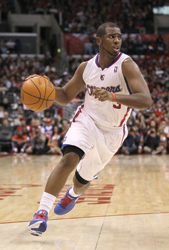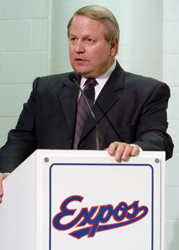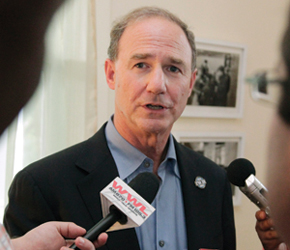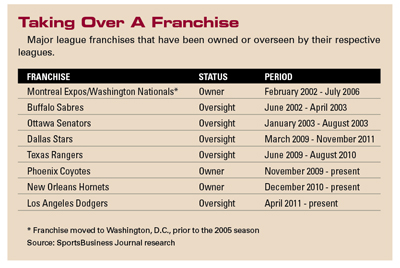Two weeks shy of this season’s NHL trade deadline, the Phoenix Coyotes clung to the Western Conference’s eighth and final playoff spot, a scant three points ahead of Calgary and Colorado and only five points ahead of 12th place, where they languished seven days earlier.
Asked whether that tenuous position would make his club a buyer or seller by the time the swap meet concludes on Feb. 27, the Coyotes’ president and chief operating officer, Mike Nealy, confessed he was not sure. His team was in the playoff hunt, but only at the fringe. His roster included several capable veterans whose contracts were expiring. This might be the time to trade out and retool for the seasons ahead.
Yet, lacking one, crucial bit of information, Nealy struggled to answer.
 |
Nealy
|
“Who is going to own the team?” Nealy asked, echoing a question that has orbited the Phoenix franchise for the 2 1/2 years since the NHL’s 29 other teams bought it out of bankruptcy. “If I owned it I might jettison everybody and be great three years from now. I’d be fine with that plan. But I don’t own it. And I don’t know who will.”
This is the rub when a league takes over the operation — or in the case of this one and the NBA’s New Orleans Hornets, ownership — of one of its franchises. Faced with the uncertainty of bankruptcy or a hastened, cut-rate sale, the NHL and NBA took the extraordinary step of buying the respective teams, convinced it was the surest way to protect asset values and maintain stability for the leagues.
It was a drastic, but logical, progression beyond the steps leagues have taken with other distressed franchises, such as the Buffalo Sabres, Ottawa Senators and Dallas Stars in hockey and the Texas Rangers and Los Angeles Dodgers in Major League Baseball, where the leagues exerted varying levels of control over operations while they sorted out matters with creditors and shopped for new owners.
On the business side — in areas such as administration, marketing and finance — executives who have lived through league oversight say it feels much like the day-to-day business of any franchise. “Frankly, at times it was more difficult with the Walt Disney Co.,” said Tony Tavares, who ran the Angels and Ducks for Disney before carving out a niche as a turnaround specialist in the last decade, first shepherding the MLB-owned Montreal Expos and then heading up the Stars.
But when it comes to matters on the ice, the field or the floor, there is something that is, well, not quite kosher.
While Nealy said his counterparts at other franchises never have called him out on it other than with the occasional, joking “I own part of you” or “You work for me” at a league meeting, he suspects that the Coyotes’ election to be buyers at the trade deadline in each of the last two seasons — and make the playoffs both times — had to be an irritant for those who were boxed out.
“In Calgary, they’re helping fund us so we can compete against them,” Nealy said. “I’m sure sometimes they scratch their heads about that. But, in the bigger picture, what’s the better alternative?”
■ ■ ■
While the Coyotes’ decision to add payroll at the deadline the last two years may have yielded a few raised eyebrows, those pale in comparison to the gaping jaws that the NBA generated in December when its ward, the Hornets, placed the world’s best point guard on the trade market.
Many in basketball would concede it was the prudent course for Hornets management. Chris Paul told the club he intended to opt out of his contract at the end of the season. Rather than risk getting nothing but salary cap space and a farewell hug, the Hornets elected to shop Paul aggressively before the start of a belated season.
 |
Despite arguably being prudent and fair, the NBA’s handling of Chris Paul’s trade to the Clippers brought backlash from fans.
GETTY IMAGES |
It was the sort of decision owners and general managers face routinely. But, because the Hornets are owned by the NBA’s 29 other teams, the process played out as anything but routine, at least from the perspective of the onlookers.
First came word — prematurely, the NBA contended later — that Paul had been traded to the Lakers. The next day, NBA Commissioner David Stern issued a statement saying Hornets management had declined the Lakers’ offer. Five days later, Paul was a Clipper.
The NBA declined to comment for this story. But on a media teleconference in the wake of the trade, Stern presented the case that the Hornets had worked the market as would any franchise.
Still, cast in whatever words, viewed through whatever prism, the core of the matter was this: The commissioner, in consultation with executives at the league, decided where the best point guard in the NBA would play this year. Stern’s choice may have been prudent; his decision measured and just. But it brought massive backlash, even public outcry, at least among sports fans.
“I knew that we were doing the best thing for New Orleans. That was my job,” Stern said after the trade. “And when you do what I’ve been doing for something dealing with the NBA for I guess approaching 40 years, you have to stick with what you think is right.
“I must confess, it wasn’t a lot of fun.”
Stern also pointed out that the NBA followed the same protocol as the NHL did in its operation of the Coyotes and Stars and that MLB did while running the Expos.
The Coyotes, Hornets and Expos are the only teams ever owned by the major U.S. sports leagues. But there have been other instances of leagues taking control — at least nominally — of imperiled franchises that were either in bankruptcy or headed for it. Nearly a decade ago, the NHL stepped in with both the Sabres and Senators. Last year, it worked with banks to fund and operate the Stars while they were sold out of a prepackaged bankruptcy.
“They’ve all been different situations,” said Bill Daly, chief operating officer and deputy commissioner of the NHL, who has acted as the league’s liaison to the teams in all those cases. “In some, our level of involvement has been quite minimal. Others have taken longer and we’ve been involved a bit more.”
MLB installed a “monitor” of the Texas Rangers when owner Tom Hicks sought bankruptcy protection in 2010, then did so again with the Dodgers for 10 weeks last year before exiting when owner Frank McCourt argued that such close oversight violated the bankruptcy code.
“It’s the last thing that anybody wants to have happen,” said John McHale, MLB’s executive vice president of administration, who served as monitor of the Rangers. “But once you are faced with the possibility that the club may either seek bankruptcy protection or be pushed toward bankruptcy, that really focuses your analysis and your decision-making process. Because that is a forum where uncertainty rules.”
■ ■ ■
Tavares was barely a week removed from a nine-year run as president of Angels and Ducks owner Disney Sports when MLB Commissioner Bud Selig called with an intriguing, unprecedented opportunity.
 |
Tony Tavares took over the Expos in 2002, the first time one of the four major U.S. leagues had owned a team.
NEWSCOM |
As part of a complex transaction that included the sales of the Florida Marlins and Boston Red Sox, MLB had spent $120 million to purchase the Montreal Expos, with the stated intention of folding the franchise. The league needed an executive to preside over what it said would be the final season for the team.
It would be the first time that any of the four major U.S. leagues took ownership of a franchise. While it would stem from vastly different circumstances than those that followed, it would face similar problems — the most prominent among them the persistent suspicion that the league might favor some teams over others when it came time to make a deal.
Tavares said Selig told him he chose him because he was “independent minded.” Selig said he didn’t want the other franchises involved in running the team; and that, frankly, he didn’t think it was the place of anyone at the league to operate a team, because it would undermine their standing with the other clubs.
“That was the key issue for me: That we could operate independently,” Tavares said. “For me, it came down to trust and knowing the person I was reporting to. Bud said what he said, and he absolutely meant it. What was important in his mind was the integrity of the team. That was paramount in his mind.”
Selig had a similar conversation with Omar Minaya, whom he hired as the Expos general manager. To operate the club, he set up a structure that was simple, which has been mirrored by the NBA and NHL as they have gone down this path. Selig and MLB President Bob DuPuy would serve in the traditional role of owners, albeit hands-off ones. Tavares would serve as CEO, overseeing business operations. Minaya would report to Tavares, with the understanding that any disputes that they couldn’t resolve might be elevated to Selig and DuPuy.
“It really wasn’t any different from what you’d see most places,” Tavares said. “You can think of Bud in the role of owner and me as chief executive officer. There are always going to be disagreements between the GM and team president. Sometimes those get elevated to the owner. But for the most part they get worked out.”
MLB budgeted the payroll, based largely on anticipated revenue. To depart from that budget, Tavares needed Selig’s approval. While their day-to-day operations and front-office structure could mirror most franchises, Selig understood from the beginning that Expos baseball decisions would invite scrutiny.
“I remember him saying, ‘You know, there are a lot of people that are going to be complaining every time you want to make a trade,’” Tavares said. “And, from what I heard, there were. There were multiple times when we were making trades that Bud was getting calls saying, ‘Hey, we were going after that player. I don’t think it’s fair. We’re a one-twenty-ninth owner in the club.’ And Bud would say ‘You know what? They’re running their club. And if they think this trade is going to improve their club, far be it from me to say it’s not.”
MLB ran the club for 4 1/2 seasons, first in Montreal and then in Washington. In that time, it was both a buyer and a seller at the trade deadline. In all those years, it never could make decisions based on the sort of long-term strategic plan of a club that projects its payroll cycle out for three or five years.
“There’s not a long-term strategy; there’s a survival strategy,” said Minaya, now senior vice president of baseball operations with the San Diego Padres. “We went to work every day trying to hold things together, and to make them better where we can. And that meant signing players and making trades. I promise you, in Montreal there was no interference at all from the commissioner’s office in what we were doing. Now, were there some teams upset? Absolutely. Because they wanted to get the players we got, or because they didn’t get the players that somebody else got from us. You’re always going to have that.
“The delicate part that you’re dealing with is, every move you make can create the perception that something is not on the up and up. That was totally false in our situation. But people are going to talk.”
Minaya said that, while his tenure in Montreal proved frustrating at times, he would undertake a challenge like it again if he could. In his two years there, only one decision stung him. In 2003, the Expos were an unlikely entrant in the race for the final playoff spot, tied with Philadelphia, Florida, Houston and St. Louis on Aug. 28. Minaya wanted to expand his roster in September, supplying a few fresh bodies and sending the message that the Expos were like the other four clubs.
The truth was, they weren’t. Tavares told Minaya that he would not ask MLB for the $50,000 needed to expand the roster. They had already outspent their budget. Tavares said that while both Minaya and manager Frank Robinson thought they should make the moves, neither made the argument that it would get them to the postseason.
The Expos went 12-15 the rest of the way and missed the playoffs by eight games.
“It wasn’t easy to go down into the clubhouse after that decision was made,” Minaya said. “The players were upset. The coaches were upset. The manager was upset. But the bottom line was we could not go over the budget. So what are you going to do?
“You can face that with any owner. It’s tough. And when the league is the owner, it’s maybe twice as tough.”
When the Coyotes beefed up for playoff runs at the last two trade deadlines, they added payroll. But, Nealy and Daly stressed, they did not exceed the budget that the NHL’s board of governors approved at the start of the season. In each of those years, general manager Don Maloney went into the season with a payroll below what the league authorized, enabling him to add what he wanted at the deadline.
Now, he faces that decision again.
“If you were going to be there a long time, you would take a look at the club every year and say, ‘Are we close? If not, let’s fix the minor league system,’” Tavares said. “But you’re not going to be there a long time. Or at least you don’t intend to. So you have to say, What would a new owner do? And that’s how you have to act.”
■ ■ ■
Just after the NBA bought the Hornets from George Shinn in December 2010 for $300 million, Stern installed Jac Sperling as chairman of the Hornets to run the cash-strapped franchise.
 |
The NBA tapped Jac Sperling to run the cash-strapped Hornets after buying the team in 2010.
AP IMAGES
|
Sperling, a New Orleans native, was chairman of the Minnesota Wild from 1997 to 2004 and he was involved in the sale of the Anaheim Ducks to Henry Samueli in 2005.
Sperling’s orders from Stern were clear: Shore up the team’s business operations and drive new business in order to attract a local buyer. Sperling kept in place the team’s top management in retaining President Hugh Weber and other key front-office staff.
“The NBA is not involved in the team’s day-to-day business operations,” Sperling said.
“We prepare a budget and it is reviewed by the league and we are accountable to achieve it. It is really not different than any other owner I have been involved with.”
The team’s basketball operations, led by general manager Dell Demps, and all other front-office staff report to Weber. Weber reports to Sperling, who answers to the league.
When the league took over the team, the debt-ridden Hornets were bleeding cash and had just 6,300 full-season-ticket holders with dwindling sponsorship revenue. Sperling and Weber quickly created an aggressive marketing plan involving city and state leaders with the goal of selling at least 10,000 full-season tickets along with a corporate campaign to boost sponsorship revenue.
City officials, local business leaders and fans have rallied around the campaign sensing that a lack of support would likely doom the team’s future in New Orleans. By late fall, the Hornets were one of 11 NBA teams to sell more than 10,000 full-season tickets. They increased sponsorship revenue by 30 percent.
“The biggest change was that we needed to drive revenue in a way that the team hadn’t done,” Sperling said. “We started at a low point and had to energize our staff to get behind the effort. It was an attitude change throughout the organization.”
In addition, Sperling and the NBA are negotiating a new long-term lease of the state-owned New Orleans Arena while peddling a naming-rights deal for the facility as they reportedly close in on a sale.
“They were ambitious goals, but we knew what was at stake,” Sperling said. “What it did was attract a lot of potential buyers, and we are now in a position where the team has a chance to be profitable.”
The metrics for the Coyotes in Phoenix are not nearly as striking, but they, too, point to progress. Ticket sales are up 20 percent this year, Nealy said. Ticket revenue is up close to 30 percent. Last year brought the highest renewal rate ever for the franchise. The Coyotes are comping fewer than half as many tickets as they were two years ago.
Still, the Coyotes are hard-pressed to come up with a strategy to deal with the most common resistance they face when selling sponsorships, or in some cases tickets.
Buyers see them as long-term commitments. They want that commitment to be reciprocal. And until it is, they’ll wait on the side.
“The bottom line is the league can’t be in a position where it’s an owner in perpetuity,” Daly said. “You are never going to maximize the business locally if there is no long-term vision and stability. The management in Phoenix has done a fantastic job. But it’s tough for business partners and fans to really embrace the franchise as long as its future is uncertain.
“And league management equals future uncertainty.”
Staff writer Tripp Mickle contributed to this report.








